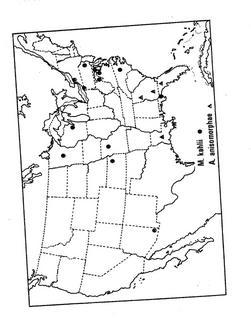
R. M. Bohart and L. S. Kimsey, 1982 · 9
Amisega kahlii |
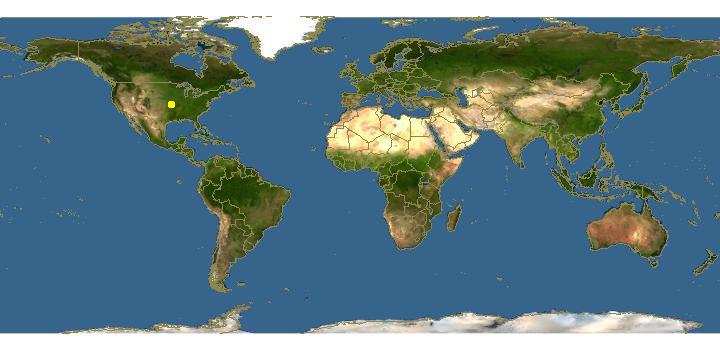
Click on map for details about points.
|
80x5 -
240x3 -
240x4 -
320x1 -
320x2 -
320x3 -
640x1 -
640x2
Set display option above.
Click on
images to enlarge. |
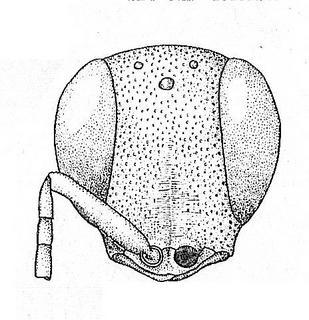
R. M. Bohart L. S. Kimsey, 1982 · 1
Amisega kahlii, head R. M. Bohart L. S. Kimsey, 1982 |
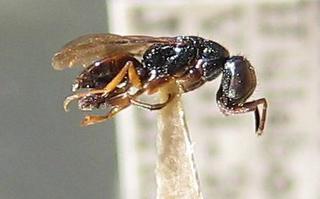
Native Bee Inventory and Monitoring Lab; Photographer: Erika Tucker · 1
Amisega kahlii |
|
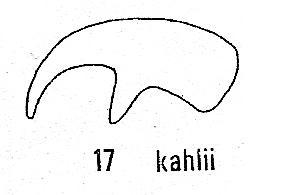
R. M. Bohart and L. S. Kimsey · 1
Amisega kahlii, claw |
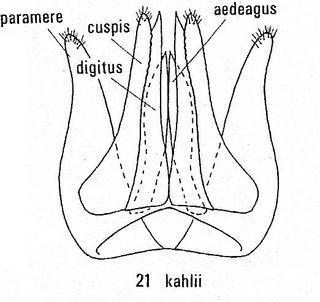
R. M. Bohart and L. S. Kimsey · 1
Amisega kahlii, male genitalia |
|
Overview |
Taken from:
R. M. Bohart and L. S. Kimsey. 1982. A Synopsis of the Chrysididae in America North of Mexico.
Mesitiopterus kahlii Ashmead
1902:231. Holotype male, Lawrence, Kansas (USNM).
Discussion: This species can be distinguished from floridensis by the smaller size, head and thorax with gold reflections, somewhat more extensive punctation of the propodeum, and aedeagus as long as the paramere (fig. 21).
Host: Milliron (1950) reported kahlii as a parasite of Diapheromera femorata Say (Phasmatidae) eggs.
Material examined: 3 males, 5 females.
Distribution: Found in most states east of the 100th meridian, specimens of kahlii have also been collected in Arizona. Records are Maryland, Pennsylvania, Missouri, Arizona, New York, Virginia, North Carolina, West Virginia, Wisconsin, Minnesota, Kansas. Collection dates are June through September.
Mesitiopterus Ashmead
Mesitiopterus Ashmead 1902:231. Generotype: Mesitiopterus kahlii Ashmead 1902, original designation.
Diagnosis: Malar space less than 0. 15 times as long as eye height (fig. 16), gena smooth; pronotum simple, without transverse submedial groove, longer than scutum; notauli absent; metanotum undeveloped; propodeum obtusely convex, without lateral teeth or angles (fig. 16); hindtarsal claw with single small subperpendicular tooth (fig. 17).
Discussion: Closely related to Amisega, Mesitiopterus can be distinguished by the absence of notauli on the scutum. This genus is found from the eastern United States west to Arizona and at least as far south as Veracruz, Mexico. Of the two species found north of Mexico, a host is known only for kahlii. We have relied heavily on Krombein (1960) for descriptions of the two species discussed below.
Key to species of Mesitiopterus
Length more than 2.4 mm, head and thorax without gold reflections
..floridensis Krombein
Length less than 2.4mm, head and thorax with gold reflections
kahlii Ashmead
AMISEGINAE
Although primarily a tropical group, several amisegine genera have nearctic species. There is also one genus, Microsega, which is apparently restricted to the southeastern United States. Amisegines are a distinctive, peculiar looking group. They superficially resemble ants, and brachyptery or aptery in females in common. Females have a slender needlelike ovipositor tube which Is apparently inserted in a hole gnawed by the wasp in a phasmatid egg in a preliminary to oviposition. The amisegines have been extensively studied by Krombein (1957, 1960).
Diagnosis: Frons without medial groove below midocellus, pronotum usually without transverse submedial groove, tarsal claws with one subsidiary tooth (fig. 17) (some Old World genera have simple tarsal claws), forewing without discoidal and cubital cells (fig. 13), radial sector short, abdominal venter convex (fig. 16), females with four external terga and males with five, T-I-II dorsally much longer than length of T-III-IV or V (fig. 13), ovipositor slender and needlelike (fig. 19).
Key to genera of Amiseginae
1. Propodeum with posterolateral teeth (fig. 13); occipital carina well developed at least dorsally; pronotal lobe touching tegula; pronotum with transverse submedial groove (fig. 13)
Adelphe Mocsary p.
Propodeum without posterolateral teeth, evenly rounded (fig. 16); occipital carina absent; pronotal lobe not reaching tegula; pronotum without transverse submedial groove (fig. 16)
.2
2. Pronotum much longer than scutum along midline, female wingless
.Microsega Krombein p.19
Pronotum about as long as scutum along midline, female with normal wings
.Mesitiopterus Ashmead p.18
|
|
| Supported by | |
Updated: 2024-04-24 14:50:32 gmt
|